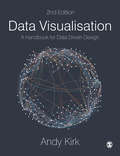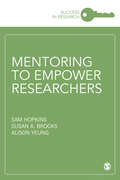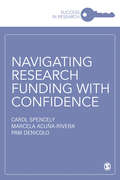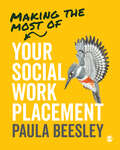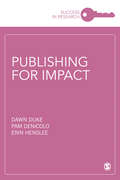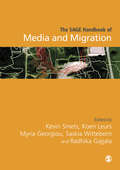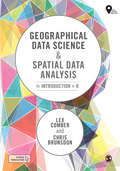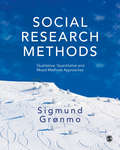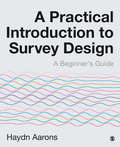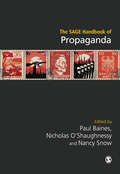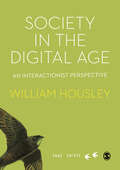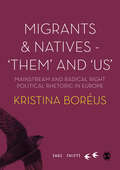- Table View
- List View
Data Visualisation: A Handbook for Data Driven Design
by Andy KirkOne of the "six best books for data geeks" - Financial Times With over 200 images and extensive how-to and how-not-to examples, this new edition has everything students and scholars need to understand and create effective data visualisations. Combining ‘how to think’ instruction with a ‘how to produce’ mentality, this book takes readers step-by-step through analysing, designing, and curating information into useful, impactful tools of communication. With this book and its extensive collection of online support, readers can: - Decide what visualisations work best for their data and their audience using the chart gallery - See data visualisation in action and learn the tools to try it themselves - Follow online checklists, tutorials, and exercises to build skills and confidence - Get advice from the UK’s leading data visualisation trainer on everything from getting started to honing the craft. Explore more resources about data visualisation and Andy Kirk.
Mentoring to Empower Researchers (Success in Research)
by Sam Hopkins Susan A Brooks Alison YeungMentorship can be a rewarding experience for both the mentor and the mentee. Within this context, this book provides guidance on how to set up mentorship programmes in your institutions, and the skills of an effective mentor, including: • Mentorship for transition points, • Skills development needed for publication, funding application and networking, • Mentorship for performing supervision duties. This is a practical and easy-to-use guide that draws on the editors&’ extensive experience, and an invaluable tool for practitioners, career advisors and academics working in research and skills development.
Mentoring to Empower Researchers (Success in Research)
by Sam Hopkins Susan A Brooks Alison YeungMentorship can be a rewarding experience for both the mentor and the mentee. Within this context, this book provides guidance on how to set up mentorship programmes in your institutions, and the skills of an effective mentor, including: • Mentorship for transition points, • Skills development needed for publication, funding application and networking, • Mentorship for performing supervision duties. This is a practical and easy-to-use guide that draws on the editors&’ extensive experience, and an invaluable tool for practitioners, career advisors and academics working in research and skills development.
Navigating Research Funding with Confidence (Success in Research)
by Professor Pam Denicolo Carol Spencely Marcela Acuna-RiveraA timely manual in the current climate of increasingly underfunded departments and institutions, this book offers insight into how to secure, manage and effectively research funding in the changing order of global economy and competing research priorities. It gives you the perspectives of those who seek, and those who award research funding, such as governments, companies and foundations. Examining the full cycle and elements of influence of research funding, this book comes with: • Practical case studies, • Lists of potential funding sources that you can use to enhance your funding generation efforts, and • Explanatory videos Clear and digestible, this text delivers systematic guidance for early career researchers and students in Graduate Schools, Doctoral Colleges, Research Methods Programmes, Academic and Research Staff Development Programmes.
Navigating Research Funding with Confidence (Success in Research)
by Professor Pam Denicolo Carol Spencely Marcela Acuna-RiveraA timely manual in the current climate of increasingly underfunded departments and institutions, this book offers insight into how to secure, manage and effectively research funding in the changing order of global economy and competing research priorities. It gives you the perspectives of those who seek, and those who award research funding, such as governments, companies and foundations. Examining the full cycle and elements of influence of research funding, this book comes with: • Practical case studies, • Lists of potential funding sources that you can use to enhance your funding generation efforts, and • Explanatory videos Clear and digestible, this text delivers systematic guidance for early career researchers and students in Graduate Schools, Doctoral Colleges, Research Methods Programmes, Academic and Research Staff Development Programmes.
Making the Most of Your Social Work Placement
by Paula Beesley'How can I succeed in my placement?' Your placement is a crucial part of your social work training - not only will a successful placement set you up to succeed in the rest of your degree, but it is also your chance to experience what real social work practice is like. This practical guide will takes you step by step through your social work placement, guiding you through what you will be expected to do, and helping you to make the most of your placement. You will learn how to apply the theory and skills you've learnt in practice, to your own observations as well as to your placement portfolio, and how to gain the feedback you need. The books is packed full of hands-on advice, alongside a variety of learning features: student voices talking about their own placement experiences, chapter checklists, reflective tasks, and potential placement pitfalls and opportunities which demonstrate different ways to approach situations you may encounter on placement.
Making the Most of Your Social Work Placement
by Paula Beesley'How can I succeed in my placement?' Your placement is a crucial part of your social work training - not only will a successful placement set you up to succeed in the rest of your degree, but it is also your chance to experience what real social work practice is like. This practical guide will takes you step by step through your social work placement, guiding you through what you will be expected to do, and helping you to make the most of your placement. You will learn how to apply the theory and skills you've learnt in practice, to your own observations as well as to your placement portfolio, and how to gain the feedback you need. The books is packed full of hands-on advice, alongside a variety of learning features: student voices talking about their own placement experiences, chapter checklists, reflective tasks, and potential placement pitfalls and opportunities which demonstrate different ways to approach situations you may encounter on placement.
Publishing for Impact (Success in Research)
by Dawn Duke Professor Pam Denicolo Erin HensleePublishing research content can be a difficult task to undertake along with other academic activities. This book addresses how newer researchers can proactively plan, write, promote and disseminate their work, and increase their chances of both academic citation and real-world impact. It focuses on how to: • Attract diverse audiences to your work, • Find value in peer review processes, • Produce multiple content from one research work, • Use multiple media such as blogs and webinars to increase output. This useful resource supports you to disseminate your work and offers forward-thinking ways to take control of your publishing processes, to enhance academic knowledge, societal impact, and the value of your research.
Publishing for Impact (Success in Research)
by Dawn Duke Professor Pam Denicolo Erin HensleePublishing research content can be a difficult task to undertake along with other academic activities. This book addresses how newer researchers can proactively plan, write, promote and disseminate their work, and increase their chances of both academic citation and real-world impact. It focuses on how to: • Attract diverse audiences to your work, • Find value in peer review processes, • Produce multiple content from one research work, • Use multiple media such as blogs and webinars to increase output. This useful resource supports you to disseminate your work and offers forward-thinking ways to take control of your publishing processes, to enhance academic knowledge, societal impact, and the value of your research.
The SAGE Handbook of Media and Migration
by Myria Georgiou Radhika Gajjala Kevin Smets Koen Leurs Saskia WittebornMigration moves people, ideas and things. Migration shakes up political scenes and instigates new social movements. It redraws emotional landscapes and reshapes social networks, with traditional and digital media enabling, representing, and shaping the processes, relationships and people on the move. The deep entanglement of media and migration expands across the fields of political, cultural and social life. For example, migration is increasingly digitally tracked and surveilled, and national and international policy-making draws on data on migrant movement, anticipated movement, and biometrics to maintain a sense of control over the mobilities of humans and things. Also, social imaginaries are constituted in highly mediated environments where information and emotions on migration are constantly shared on social and traditional media. Both, those migrating and those receiving them, turn to media and communicative practices to learn how to make sense of migration and to manage fears and desires associated with cross-border mobility in an increasingly porous but also controlled and divided world. The SAGE Handbook of Media and Migration offers a comprehensive overview of media and migration through new research, as well as a review of present scholarship in this expanding and promising field. It explores key interdisciplinary concepts and methodologies, and how these are challenged by new realities and the links between contemporary migration patterns and its use of mediated processes. Although primarily grounded in media and communication studies, the Handbook builds on research in the fields of sociology, anthropology, political science, urban studies, science and technology studies, human rights, development studies, and gender and sexuality studies, to bring to the forefront key theories, concepts and methodological approaches to the study of the movement of people. In seven parts, the Handbook dissects important areas of cross-disciplinary and generational discourse for graduate students, early career researcher, migration management practitioners, and academics in the fields of media and migration studies, international development, communication studies, and the wider social science discipline. Part One: Keywords and Legacies Part Two: Methodologies Part Three: Communities Part Four: Representations Part Five: Borders and Rights Part Six: Spatialities Part Seven: Conflicts
The SAGE Handbook of Media and Migration
Migration moves people, ideas and things. Migration shakes up political scenes and instigates new social movements. It redraws emotional landscapes and reshapes social networks, with traditional and digital media enabling, representing, and shaping the processes, relationships and people on the move. The deep entanglement of media and migration expands across the fields of political, cultural and social life. For example, migration is increasingly digitally tracked and surveilled, and national and international policy-making draws on data on migrant movement, anticipated movement, and biometrics to maintain a sense of control over the mobilities of humans and things. Also, social imaginaries are constituted in highly mediated environments where information and emotions on migration are constantly shared on social and traditional media. Both, those migrating and those receiving them, turn to media and communicative practices to learn how to make sense of migration and to manage fears and desires associated with cross-border mobility in an increasingly porous but also controlled and divided world. The SAGE Handbook of Media and Migration offers a comprehensive overview of media and migration through new research, as well as a review of present scholarship in this expanding and promising field. It explores key interdisciplinary concepts and methodologies, and how these are challenged by new realities and the links between contemporary migration patterns and its use of mediated processes. Although primarily grounded in media and communication studies, the Handbook builds on research in the fields of sociology, anthropology, political science, urban studies, science and technology studies, human rights, development studies, and gender and sexuality studies, to bring to the forefront key theories, concepts and methodological approaches to the study of the movement of people. In seven parts, the Handbook dissects important areas of cross-disciplinary and generational discourse for graduate students, early career researcher, migration management practitioners, and academics in the fields of media and migration studies, international development, communication studies, and the wider social science discipline. Part One: Keywords and Legacies Part Two: Methodologies Part Three: Communities Part Four: Representations Part Five: Borders and Rights Part Six: Spatialities Part Seven: Conflicts
Geographical Data Science and Spatial Data Analysis: An Introduction in R (Spatial Analytics and GIS)
by Lex Comber Chris BrunsdonWe are in an age of big data where all of our everyday interactions and transactions generate data. Much of this data is spatial – it is collected some-where – and identifying analytical insight from trends and patterns in these increasing rich digital footprints presents a number of challenges. Whilst other books describe different flavours of Data Analytics in R and other programming languages, there are none that consider Spatial Data (ie the location attached to data), or that consider issues of inference, linking Big Data, Geography, GIS, Mapping and Spatial Analytics. This is a ‘learning by doing’ text book, building on the previous book by the same authors, An Introduction to R for Spatial Analysis and Mapping. It details the theoretical issues in analyses of Big Spatial Data and developing practical skills in the reader for addressing these with confidence.
Geographical Data Science and Spatial Data Analysis: An Introduction in R (Spatial Analytics and GIS)
by Lex Comber Chris BrunsdonWe are in an age of big data where all of our everyday interactions and transactions generate data. Much of this data is spatial – it is collected some-where – and identifying analytical insight from trends and patterns in these increasing rich digital footprints presents a number of challenges. Whilst other books describe different flavours of Data Analytics in R and other programming languages, there are none that consider Spatial Data (ie the location attached to data), or that consider issues of inference, linking Big Data, Geography, GIS, Mapping and Spatial Analytics. This is a ‘learning by doing’ text book, building on the previous book by the same authors, An Introduction to R for Spatial Analysis and Mapping. It details the theoretical issues in analyses of Big Spatial Data and developing practical skills in the reader for addressing these with confidence.
Geographical Data Science and Spatial Data Analysis: An Introduction in R (Spatial Analytics and GIS)
by Lex Comber Chris BrunsdonWe are in an age of big data where all of our everyday interactions and transactions generate data. Much of this data is spatial – it is collected some-where – and identifying analytical insight from trends and patterns in these increasing rich digital footprints presents a number of challenges. Whilst other books describe different flavours of Data Analytics in R and other programming languages, there are none that consider Spatial Data (ie the location attached to data), or that consider issues of inference, linking Big Data, Geography, GIS, Mapping and Spatial Analytics. This is a ‘learning by doing’ text book, building on the previous book by the same authors, An Introduction to R for Spatial Analysis and Mapping. It details the theoretical issues in analyses of Big Spatial Data and developing practical skills in the reader for addressing these with confidence.
Social Research Methods: Qualitative, Quantitative and Mixed Methods Approaches
by Sigmund GrønmoStructured around one of the concepts students struggle with the most—the research question—this book begins with how to understand the role of good questions before demonstrating how questions underpin good research designs and how social research can be framed as asking and answering questions. Perfect for undergraduate students new to methods, it teaches students how qualitative, quantitative, and mixed methods research can be used to answer these questions. "An incredibly resourceful book that contains a forensic insight into social research methods, offering the full range of contemporary approaches. Students will find particular value in the accessibility and detail of the text. Each chapter provides a set of learning outcomes, study questions and further reading." - Dr Ruth McAreavey, Newcastle University Supported by a website that maps online resources to key stages of the learning process, it helps students: - Understand the scientific method - Learn the vocabulary of social science research - Plan and design research - Practice with and interpret data - Explore social science literature and improve assignments with good citations - Improve critical thinking. - Extensive visualizations, overviews, examples, exercises, and other learning features, make this the perfect introductory text to build confidence and best practice around research methods.
Social Research Methods: Qualitative, Quantitative and Mixed Methods Approaches
by Sigmund GrønmoStructured around one of the concepts students struggle with the most—the research question—this book begins with how to understand the role of good questions before demonstrating how questions underpin good research designs and how social research can be framed as asking and answering questions. Perfect for undergraduate students new to methods, it teaches students how qualitative, quantitative, and mixed methods research can be used to answer these questions. "An incredibly resourceful book that contains a forensic insight into social research methods, offering the full range of contemporary approaches. Students will find particular value in the accessibility and detail of the text. Each chapter provides a set of learning outcomes, study questions and further reading." - Dr Ruth McAreavey, Newcastle University Supported by a website that maps online resources to key stages of the learning process, it helps students: - Understand the scientific method - Learn the vocabulary of social science research - Plan and design research - Practice with and interpret data - Explore social science literature and improve assignments with good citations - Improve critical thinking. - Extensive visualizations, overviews, examples, exercises, and other learning features, make this the perfect introductory text to build confidence and best practice around research methods.
A Practical Introduction to Survey Design: A Beginner′s Guide
by Haydn AaronsThis is your definitive guide to designing your social survey. It includes all the knowledge and skills you need to plan your survey with confidence and ease. Every step of survey design from developing your questions, to administering your survey and preparing your data for analysis, is explained in easy to follow language. It features: Case studies demonstrating how effective surveys are conducted in real life Clear advice on how to design an ethical social survey Practical exercises to help you construct your survey Suggestions for further reading taken from cutting edge, multidisciplinary sources The book also comes with a host of useful online resources, including templates and reflective questions, to help strengthen your understanding and apply your new found knowledge.
A Practical Introduction to Survey Design: A Beginner′s Guide
by Haydn AaronsThis is your definitive guide to designing your social survey. It includes all the knowledge and skills you need to plan your survey with confidence and ease. Every step of survey design from developing your questions, to administering your survey and preparing your data for analysis, is explained in easy to follow language. It features: Case studies demonstrating how effective surveys are conducted in real life Clear advice on how to design an ethical social survey Practical exercises to help you construct your survey Suggestions for further reading taken from cutting edge, multidisciplinary sources The book also comes with a host of useful online resources, including templates and reflective questions, to help strengthen your understanding and apply your new found knowledge.
A Practical Introduction to Survey Design: A Beginner′s Guide
by Haydn AaronsThis is your definitive guide to designing your social survey. It includes all the knowledge and skills you need to plan your survey with confidence and ease. Every step of survey design from developing your questions, to administering your survey and preparing your data for analysis, is explained in easy to follow language. It features: Case studies demonstrating how effective surveys are conducted in real life Clear advice on how to design an ethical social survey Practical exercises to help you construct your survey Suggestions for further reading taken from cutting edge, multidisciplinary sources The book also comes with a host of useful online resources, including templates and reflective questions, to help strengthen your understanding and apply your new found knowledge.
The SAGE Handbook of Propaganda
by Nancy Snow Paul Baines Nicholas O'ShaughnessyThe SAGE Handbook of Propaganda unpacks the ever-present and exciting topic of propaganda to explain how it invades the human psyche, in what ways it does so, and in what contexts. As a beguiling tool of political persuasion in times of war, peace, and uncertainty, propaganda incites people to take, often violent, action, consciously or unconsciously. This pervasive influence is particularly prevalent in world politics and international relations today. In this interdisciplinary Handbook, the editors have gathered together a group of world-class scholars from Europe, America, Asia, and the Middle East, to discuss leadership propaganda, war propaganda, propaganda for peace marketing, propaganda as a psychological tool, terror-enhanced propaganda, and the contemporary topics of internet-mediated propaganda. Unlike previous publications on the subject, this book brings to the forefront current manifestations and processes of propaganda such as Islamist, and Far Right propaganda, from interdisciplinary perspectives. In its four parts, the Handbook offers researchers and academics of propaganda studies, peace and conflict studies, media and communication studies, political science and governance marketing, as well as intelligence and law enforcement communities, a comprehensive overview of the tools and context of the development and evolution of propaganda from the twentieth century to the present: Part One: Concepts, Precepts and Techniques in Propaganda Research Part Two: Methodological Approaches in Propaganda Research Part Three: Tools and Techniques in Counter-Propaganda Research Part Four: Propaganda in Context
The SAGE Handbook of Propaganda
The SAGE Handbook of Propaganda unpacks the ever-present and exciting topic of propaganda to explain how it invades the human psyche, in what ways it does so, and in what contexts. As a beguiling tool of political persuasion in times of war, peace, and uncertainty, propaganda incites people to take, often violent, action, consciously or unconsciously. This pervasive influence is particularly prevalent in world politics and international relations today. In this interdisciplinary Handbook, the editors have gathered together a group of world-class scholars from Europe, America, Asia, and the Middle East, to discuss leadership propaganda, war propaganda, propaganda for peace marketing, propaganda as a psychological tool, terror-enhanced propaganda, and the contemporary topics of internet-mediated propaganda. Unlike previous publications on the subject, this book brings to the forefront current manifestations and processes of propaganda such as Islamist, and Far Right propaganda, from interdisciplinary perspectives. In its four parts, the Handbook offers researchers and academics of propaganda studies, peace and conflict studies, media and communication studies, political science and governance marketing, as well as intelligence and law enforcement communities, a comprehensive overview of the tools and context of the development and evolution of propaganda from the twentieth century to the present: Part One: Concepts, Precepts and Techniques in Propaganda Research Part Two: Methodological Approaches in Propaganda Research Part Three: Tools and Techniques in Counter-Propaganda Research Part Four: Propaganda in Context
Society in the Digital Age: An Interactionist Perspective (SAGE Swifts)
by William HousleyIn Digital Society: An Interactionist Perspective, William Housley explores the ways interactionist thinking contributes to our understanding of current trends and topics within digital sociology. Drawing on a range of aligned approaches, concepts and empirical studies, he explores how notions of self and presentation, action and agency, practical reason and interaction are of fundamental importance to our understanding of some of the emerging contours of digital society; inclusive of big data, social media, the social life of methods, algorithmic culture, ‘artificial intelligence’ and the pivot to voice. In doing so, Housley aims to demonstrate the enduring relevance of work associated with Goffman, Garfinkel and Sacks in understanding everyday digital social life. The book provides a range of insights into how sociology and social science continues to draw upon interactionism and aligned traditions such as ethnomethodology in making sense of the Interaction Order 2.0 and beyond.
Society in the Digital Age: An Interactionist Perspective (SAGE Swifts)
by William HousleyIn Digital Society: An Interactionist Perspective, William Housley explores the ways interactionist thinking contributes to our understanding of current trends and topics within digital sociology. Drawing on a range of aligned approaches, concepts and empirical studies, he explores how notions of self and presentation, action and agency, practical reason and interaction are of fundamental importance to our understanding of some of the emerging contours of digital society; inclusive of big data, social media, the social life of methods, algorithmic culture, ‘artificial intelligence’ and the pivot to voice. In doing so, Housley aims to demonstrate the enduring relevance of work associated with Goffman, Garfinkel and Sacks in understanding everyday digital social life. The book provides a range of insights into how sociology and social science continues to draw upon interactionism and aligned traditions such as ethnomethodology in making sense of the Interaction Order 2.0 and beyond.
Society in the Digital Age: An Interactionist Perspective (SAGE Swifts)
by William HousleyIn Digital Society: An Interactionist Perspective, William Housley explores the ways interactionist thinking contributes to our understanding of current trends and topics within digital sociology. Drawing on a range of aligned approaches, concepts and empirical studies, he explores how notions of self and presentation, action and agency, practical reason and interaction are of fundamental importance to our understanding of some of the emerging contours of digital society; inclusive of big data, social media, the social life of methods, algorithmic culture, ‘artificial intelligence’ and the pivot to voice. In doing so, Housley aims to demonstrate the enduring relevance of work associated with Goffman, Garfinkel and Sacks in understanding everyday digital social life. The book provides a range of insights into how sociology and social science continues to draw upon interactionism and aligned traditions such as ethnomethodology in making sense of the Interaction Order 2.0 and beyond.
Migrants and Natives - ′Them′ and ′Us′: Mainstream and Radical Right Political Rhetoric in Europe (SAGE Swifts)
by Kristina BoréusIn light of the recent global resurgence of radical and populist right-wing parties, this book examines hostile and anti-immigration rhetoric in Europe. Topical and timely, it deftly guides the reader through the trajectories of radical right parties and contextualises discriminatory rhetoric in wider immigration and integration politics. Grounded in a focussed, comparative critical discourse study that draws on methods from social science and linguistics, the book: Presents a study of political rhetoric on migration in several European countries over the past thirty-five years, drawing out similarities and differences. Explores anti-immigration rhetoric before and after the 2015 refugee/solidarity crisis. Illuminates the role of so-called ‘mainstream’ parties in developing and legitimising discriminatory rhetoric. Exposing the insidious nature of malevolent political rhetoric and its consequences, this book is a timely and essential read.
